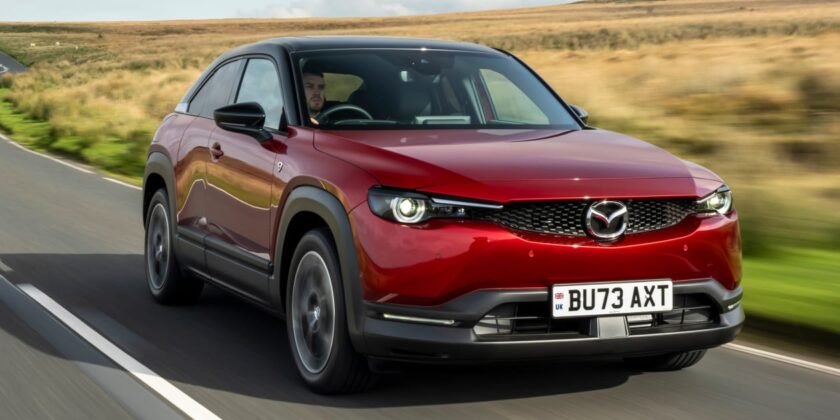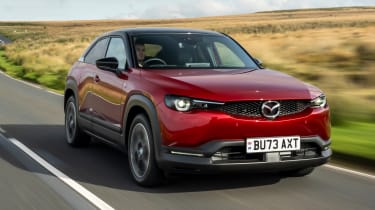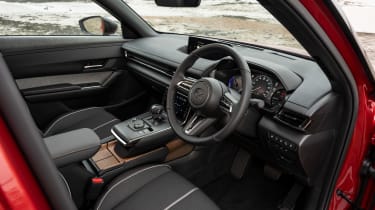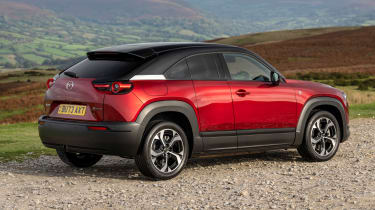The electric MX-30 has always been hampered by its limited range, but now Mazda has introduced a rotary plug-in hybrid powertrain
3.5 out of 5
How we review carsFind your Mazda MX-30Offers from our trusted partners on this car and its predecessors…
There are three drive modes available: EV, Normal and Charge. As its name suggests, EV mode sends the engine into hibernation, only waking from its slumber when the battery is close to empty or some extra energy is required for hard acceleration.
The MX-30 remains comfortable and composed on twisty roads, able to change direction quickly with not too much body roll. However, the tall and long bonnet makes it hard to place the car on the road, and pushing the MX-30 too far will lead it to understeer.
After covering more than 100 miles across motorways, and winding through Welsh valleys, we only managed 40mpg – a far cry from the 282.5mpg Mazda claims this setup is capable of. Of course, all plug-in hybrids need regular charging and minimal use of the engine to achieve their claimed stats; we did see a rather remarkable 5mi/kWh from the battery.
Recharging the MX-30 R-EV’s battery from 20-80 per cent via a 7.2kW home wallbox takes an hour and a half. The R-EV also gets DC charging capabilities, which is uncommon for a PHEV, so you could use a 50kW rapid charger to complete the same top-up in 25 minutes. We doubt many will stop on longer journeys to charge, however, as they can just let the rotary engine do its thing.
Inside, the MX-30 R-EV and regular EV are almost identical, which is no bad thing. The cabin feels incredibly sophisticated and mature for a crossover, and build quality is impressive. The tech on-board is also easy to use thanks to the extensive use of physical buttons and switchgear, plus the large rotary dial for navigating the infotainment system. The 8.8-inch central display itself is very sharp, although because of how narrow the screen is it doesn't give you a great view of what’s coming up on the sat-nav.
There’s lots of adjustment in the driving position, while the thin rimmed steering wheel is great to hold and features paddles to allow you adjust the strength of the regenerative braking on the fly.
The rear coach doors are still more trouble than they're worth, though. The small openings they create makes getting into the rear a challenge, and the small porthole-like windows not only don’t open, but don’t let a lot of light in, creating a rather gloomy place for passengers. The huge B-pillar and small rear windows also create huge blind spots – at least Mazda has made blind-spot detection standard-fit on every model.
The MX-30 R-EV and EV are available in the same three trim levels, and for the most part cost exactly the same. Entry-level Prime-Line models start from £31,250, and come with LED headlamps, 18-inch alloy wheels, all-round parking sensors, a reversing camera, head-up display, 8.8-inch infotainment system, plus a separate seven-inch touchscreen for the climate controls, cruise control, lane departure warning, and Apple CarPlay and Android Auto smartphone connectivity.
Upgrading to Exclusive-Line sees the price jump to £33,150, and adds an eight-way adjustable driver’s seat, heated front seats, Leatherette upholstery, keyless entry and diamond-cut wheels. Range-topping Makoto trim cars like the one we drove, cost £36,000 in R-EV form – £450 more than the equivalent EV – and get luxuries like a 360-degree parking camera setup, an opening sunroof, heated steering wheel, and a 12-speaker Bose sound system.
We tested all three versions of the MX-30 R-EV back to back and found that base models feel just as premium inside as top-spec versions, and certainly not short on kit, making Prime-Line our pick of the range.
| Model: | Mazda MX-30 R-EV Makoto |
| Price: | £36,000 |
| Powertrain: | 0.8-litre single-rotor petrol PHEV, 17.8kWh battery, 1x e-motor |
| Transmission: | Single-speed automatic, front-wheel drive |
| 0-62mph: | 9.1 seconds |
| Top speed: | 87mph |
| EV range: | 53 miles |
| Economy: | 282.5mpg |
| CO2: | 21g/km |
| On sale: | Now |
Source: Read Full Article






